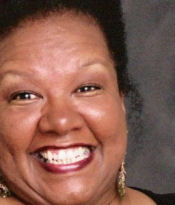|
 Sharon Ewell Foster is a
critically acclaimed, award-winning author, speaker, and teacher. She
is the author of Passing by Samaria, the first
successful work of Christian fiction by an African American author, and
six other works of fiction. Her works regularly receive starred book
reviews—which is a rarity among writers—and has won a Christy Award,
the Gold Pen Award, Best of Borders, and several reviewers’ choice
awards. Sharon Ewell Foster is a
critically acclaimed, award-winning author, speaker, and teacher. She
is the author of Passing by Samaria, the first
successful work of Christian fiction by an African American author, and
six other works of fiction. Her works regularly receive starred book
reviews—which is a rarity among writers—and has won a Christy Award,
the Gold Pen Award, Best of Borders, and several reviewers’ choice
awards.
Last month, Foster’s highly
anticipated new novel realeased.
The Resurrection of Nat
Turner, Part 1: The Witnesses (Simon & Schuster) is a
story about how Harriet Beecher Stowe, author of Uncle Tom’s
Cabin, aims to clarify the accepted history of Nat Turner’s
prosecution. Turner, the Ethiopian turned American slave, is a
well-read patriot in slaves’ eyes, but an ornery slave who needs to be
put in his place in his mistress’s eyes.
Foster continues her chat with Christian
Fiction Online Magazine about this controversial novel, her
questions to God about her writer’s journey, and how her readers were
her saving grace.
Share the
premise of this story.
The arguments that still rage
today are: Was Nat Turner a hero or a villain? Was he a faithful
preacher or a religious fanatic? Those questions are at the heart of
the book. Even 180 years later, groups see him differently. I wanted to
explore that.
In social science and
educational theory, there is something called the Jahari Window. It
basically says that who we are is how we see ourselves, how others see
us, things we keep from others, and things others see about us that we
cannot see ourselves.
In The Resurrection of
Nat Turner, we learn who Nat Turner is from others—both his
friends and his foes—and in Part 2 we hear from him.
Throughout both books, Harriet
Beecher Stowe is searching for the real Nat Turner. Twenty-five years
after Turner’s death, Frederick Douglass and her brother encourage her
to write a book about him.
Stowe actually did write a book
about Nat Turner called Dred. I was intrigued at
the idea of her writing a book about this radical revolutionary after
penning a story about a passive slave. I researched, found a possible
connection, and her quest became the overarching theme that holds the
story together. Dave Lambert suggested that I let her light shine
brighter, and it all fell into place.
What themes in
this story are relevant to our current Christian worldview?
I’m always fascinated by how our
past speaks to our present.
It is about love.
Slavery, trafficking—no matter
what country, race, or age—is very simply our failure to see one
another as brothers, to love one another. We can try to intellectualize
it, but it is what it is.
It is about the power of truth
and the power of lies. Many people, lots of black men, find it hard to
love God because of the lies they’ve been told—lies like God doesn’t
love them, God meant for them to be slaves, God says people are
inferior or superior because of the color of their skin.
In the books, I explore lies
that are so ubiquitous that we have come to accept them as truth—even
when those lies fly in the face of God’s Word. I explore the power of
the truth to overcome even the oldest lie.
|
Finally,
it is about our innate desire for liberty, self-determination. The Resurrection
of Nat Turner is about hoping, fighting, and pressing on when
all the odds are against you.
It is about God’s love, which
transcends language, culture, race, and His commitment to even the
least among us.
What was your
process for putting this series together?
I’m usually a very economical
writer. I don’t have pages and chapters that have to be edited out. But
I had to write and write, just trying to find the truth. At first, the
writing was like this huge piece of rock on the side of the mountain
and I needed to hammer at it, to chisel at it to find the sculpture
within.
In the beginning, I told Nat
Turner’s story from the points of view of those who knew him. I thought
it would be simple, like building a small church. Then, before my eyes,
it became this massive thing—a cathedral.

When I wanted to give up, I kept
praying. Readers kept writing to encourage me. When I felt overwhelmed,
I reminded myself that it takes years to build a cathedral.
What do we
learn about Nat Turner that changes the mystique behind his infamous
name?
Without giving too much away,
all the writing about Nat Turner, fiction and nonfiction, has been
based on Nat Turner’s alleged confession given to his attorney, Thomas
Gray. When I read the trial transcripts, the first things I saw were:
Nat Turner offered no confession at the trial—instead, he pled
innocent!—Thomas Gray was also not Turner’s appointed attorney!
So, all we’ve believed for
years, what we’ve been taught in school was a lie. It has made me
wonder how much of what we believe is history is really only fiction.
I set out on this five-year
journey to unravel the mystery: Who was Nat Turner? Why all the effort
to paint this picture of a slave, of someone who wasn’t considered
human? The governor of Virginia was getting instant transcripts and
knew the pamphlet, “The Confessions of Nat Turner as told to Thomas
Gray” was a lie. Why was he silent?
It’s been a fascinating journey.
We may be part of rectifying history as the 180th anniversary dawns.
Hero or villain, maybe finally, Nat Turner will have his day in court.
Read the book and spread the truth.
What haven’t I
asked that you would like CFOM to know about The
Witness?
The Resurrection of Nat
Turner, Part 1: The Witnesses released August 2, 2011, in
trade paperback, audio, and e-book formats online and wherever books
are sold. Thank you, again, for all the love. Read the book and spread
the truth.
If you’d like to schedule a book
signing, interview, or appearance, e-mail me at
sharonewelfoster@aol.com or hit me on Facebook at Sharon Ewell Foster
(I’m starting a fan page soon).

|









 Sharon Ewell Foster is a
critically acclaimed, award-winning author, speaker, and teacher. She
is the author of Passing by Samaria, the first
successful work of Christian fiction by an African American author, and
six other works of fiction. Her works regularly receive starred book
reviews—which is a rarity among writers—and has won a Christy Award,
the Gold Pen Award, Best of Borders, and several reviewers’ choice
awards.
Sharon Ewell Foster is a
critically acclaimed, award-winning author, speaker, and teacher. She
is the author of Passing by Samaria, the first
successful work of Christian fiction by an African American author, and
six other works of fiction. Her works regularly receive starred book
reviews—which is a rarity among writers—and has won a Christy Award,
the Gold Pen Award, Best of Borders, and several reviewers’ choice
awards. 